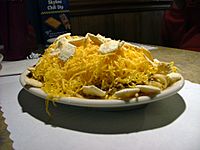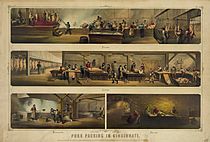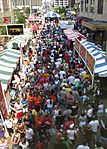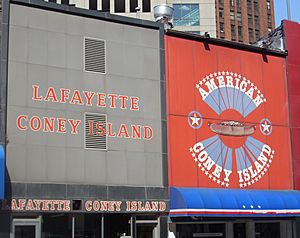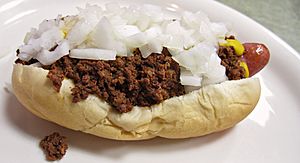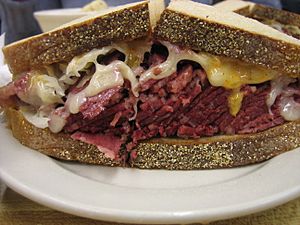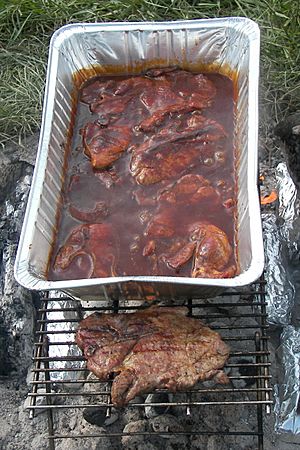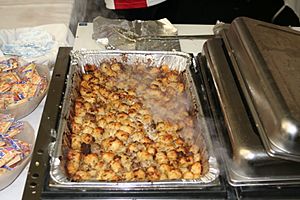Cuisine of the Midwestern United States facts for kids
Midwestern cuisine is the yummy food style from the Midwestern United States. It gets its flavors from places like Central, Northern, and Eastern Europe, as well as from Native American cooking. The food is also shaped by what grows well in the Midwest and the many different cultures living there.
Everyday cooking in Midwestern homes often features simple, filling meals. These dishes use lots of fresh, local ingredients. You might even think of them as classic "American food." Restaurants in the Midwest also offer many different kinds of ethnic foods. They also use cool, modern cooking styles.
Contents
What is Midwestern Cuisine?
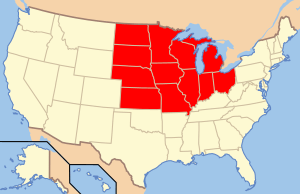
The Midwest is sometimes called "the breadbasket of America." This is because it grows a lot of grains. Think of wheat, corn, and soybeans!
Some traditional Midwestern foods include Graham bread, steamed cornbread, and johnny cakes. Sweet treats like butter cakes are also popular. These include chocolate cake, devil's food cake, coconut cake, and fruit cake. People also used flour to make sponge cakes, doughnuts, cookies, and quick breads. Examples are soda bread and baking powder biscuits. Grains like oatmeal and corn meal were often made into a thick porridge called "mush."
For a long time, processing beef and pork has been a big business in the Midwest. Cities like Chicago and Kansas City were huge centers for raising and processing beef. Cincinnati was even called "Porkopolis" because it was once the world's biggest pork city. Today, Iowa is the main place for pork production in the U.S.
People used to preserve meats by curing them. This is how we got corned beef, sugar-cured ham, and bacon. Pork sausages were often flavored with black pepper and sage. They were also smoked to make frankfurters. Sometimes, liver, heart, and bread were added to make breakfast sausages.
Other sausages included liver sausage, blood sausage, bologna, and wiener wurst. Hamburg steak was made from tougher cuts of beef.
Common ingredients in the Midwest are beef, pork, potatoes, and corn. Apple pie is also very popular. Other local ingredients change depending on the state. Potatoes are often steamed, boiled, or added to a potato chowder. This soup is made with milk, butter, and salt pork. You can also find German potato salad and potato dumplings in local pubs. The Upper Midwest has special foods like morel mushrooms, strawberries, blackcaps, and blackberries.
Food from the Past
In the 1800s, as people moved west, they had to change recipes. They used whatever ingredients they could find. A typical Midwestern breakfast back then might have had lamb chops, liver, bacon, pan-fried fish, eggs, and potatoes. It also included fruit compote or preserves. Hearty dough dishes like pie, doughnuts, or cookies were also common.
During harvest time, families ate mostly food they grew themselves. Their tables would be full of fried chicken, pickles, beets, cottage cheese, roast meats, potatoes, pork chops, fresh bread, fried green tomatoes, and pies.
German and Swiss immigrants made dairy products like cheese, milk, butter, and homemade cottage cheese. They also raised milk-fed veal. People from Sweden, Norway, and Finland started settling in the Midwest in the late 1700s. They brought delicious, buttery cakes and cookies.
How Immigrants Shaped the Food
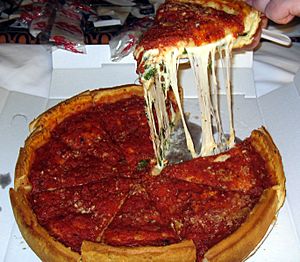
Like many American food styles, Midwestern cooking has been greatly changed by immigrant groups.
In the northern Midwest, many people came from northern Europe. So, you'll find Swedish pancakes and Polish pierogi there. States like Wisconsin, Missouri, Kansas, Ohio, and Illinois welcomed many German immigrants. This is why pork sausages and potatoes are very common.
In the "Rust Belt" (an area with many old factories), many Greeks became restaurant owners. They brought a Mediterranean influence to the food. You can also see Native American influences in how corn and wild rice are used.
German immigrants brought dishes like Hassenpfeffer, sauerbraten, Spätzle, Schnitzel, and pumpernickel bread. Scandinavian dishes include pickled fish, smoked fish, lutefisk, dark breads, and Danish frikadeller. They also brought aebleskiver (round pancakes) served with chokecherry or blueberry syrup.
A "Wurst mart" is a special event, often held by churches to raise money. People pay for a buffet of sausages and side dishes. Common sides include mashed potatoes, gravy, and sauerkraut. "Wurst mart" comes from the German words for "sausage market." You'll find these mostly in small German-American towns in the Midwest, especially near St. Louis.
Cities and Their Special Foods
Chicago
After the Civil War, Chicago used its railway system to send fresh beef everywhere. For the first time, people across America could buy fresh beef. Chicago meat packer Gustavus F. Swift helped make this possible with refrigerated railroad cars.
Chicago is known for its hot dogs. Vienna Beef became a big producer of hot dogs. Other famous Chicago meatpackers include Armour and Oscar Meyer.
Jewish immigrants from Eastern Europe ate a type of oatmeal cereal called krupnik. It sometimes had barley, potatoes, and fat. Orthodox Jews continued to follow kashrut (kosher food rules). Workers often carried bagels, knish, and herring for lunch.
Chicago's Greektown serves traditional dishes like gyros and flaming cheese saganaki. Steamed tamales have been available in Chicago since the 1800s.
Thin-crust pizza came to Chicago with Italian immigrants in 1909. The story of deep-dish pizza is debated. Some say Pizzeria Uno first served it in 1943. After World War II, American soldiers came home wanting Italian food. So, pepper and onion Italian pork sausage sandwiches became very popular. You can still find them at festivals and ballparks today.
Italians in Chicago are also known for Chicken Vesuvio. This dish has bone-in chicken cooked with oregano and garlic in a white-wine sauce. It's finished in the oven with potatoes.
Many famous food companies started in Chicago. James L. Kraft founded his cheese business there in 1903, which became Kraft Foods. Miracle Whip was introduced in 1933. The American Licorice Company (makers of Red Vines) started in Chicago in 1914. Brach's company began making candy corn in the 1920s. The Dove Bar was also invented in Chicago. Cracker Jack was founded by a German immigrant who sold molasses-coated popcorn in Chicago in 1871.
Chicago is famous for its sandwiches. The Italian beef sandwich started during the Great Depression. Tough cuts of beef are cooked slowly, sliced thin, and served with sweet green pepper. It's on a roll softened in the beef's juices.
Chicago's Puerto Rican community brought the Jibarito sandwich. It uses fried green plantain instead of bread. Today, you can find this sandwich with chicken, roast pork, ham, shrimp, or even tofu.
The Chicago-style hot dog is an all-beef frankfurter. It's served in a poppy seed bun with mustard, white onion, relish, pickles, tomato wedges, sport peppers, and celery salt.
Cincinnati
The Queen City is famous for its Cincinnati chili. This Greek-inspired meat sauce has ground beef seasoned with cinnamon, nutmeg, allspice, cloves, bay leaf, and cumin. It's served over spaghetti or hot dogs. Unlike regular chili, Cincinnati chili is almost never eaten by itself. It's usually served in "ways" or on cheese coneys.
Goetta is a meat-and-grain sausage or mush made from pork and oats. It's special to the Greater Cincinnati area. It's similar to a German peasant food called stippgrutze. But goetta has more meat and is thicker, so you can slice it. Slices are usually fried like sausage patties and served for breakfast. Over a million pounds of goetta are eaten in Cincinnati each year!
Cincinnati has a strong German background. You can find many German restaurants and foods there. Oktoberfest Zinzinnati is an annual food and music festival in September. It's the second-largest Oktoberfest in the world! Taste of Cincinnati is the oldest food festival in the U.S. It happens every year on Memorial Day weekend.
Cleveland
Cleveland's many immigrant groups have greatly influenced its food. Italian foods and Eastern European foods are very popular. These include dishes from Poland and Hungary.
You'll find cavatelli, rigatoni, pizza, Chicken paprikash, stuffed cabbage, pierogi, and kielbasa everywhere in Cleveland. Local specialties include City Chicken (a pork dish) and the Polish Boy. The Polish Boy is a loaded sausage sandwich. These dishes show that Cleveland's food is hearty and affordable.
Sweets unique to Cleveland include the coconut bar. These are small squares of cake dipped in chocolate and rolled in coconut. In Italian bakeries, a special version of cassata cake is popular. This local cake has layers of sponge cake, custard, and strawberries. It's frosted with whipped cream.
Columbus

The Columbus, Ohio area is where many famous fast-food chains started. Especially those known for hamburgers! Wendy's opened its first store in Columbus in 1969. America's oldest hamburger chain, White Castle, is also based there.
Besides burgers, Columbus is known for the German Village. This neighborhood has German food like sausages and kuchen. In recent years, restaurants that use organic and local food have become popular. You can also find many Somali restaurants in the city.
Columbus is also the birthplace of the famous Marzetti Italian Restaurant, opened in 1896. The owner, Teresa Marzetti, created the beef-and-pasta casserole named after her brother-in-law, Johnny Marzetti.
Detroit
Detroit is famous for its Coney Island hot dogs. You can find them at many "Coney Island" restaurants. A coney is a hot dog with a ground beef sauce, chopped onions, and mustard. The Coney Special has extra ground beef on top. It's often served with French fries.

Detroit also has its own style of pizza. It's a thick, rectangular pizza called Detroit-style pizza. Other Detroit foods include zip sauce (for steaks) and the triple-decker Dinty Moore sandwich. This sandwich has corned beef, lettuce, tomato, and Russian dressing. There's also a Chinese-American dish called warr shu gai (almond boneless chicken).
Detroit has many large groups of immigrants. A big Arabic-speaking population lives in Dearborn. You'll find many Lebanese stores there. Detroit also has many Greek restaurant owners. So, lots of Mediterranean restaurants are in the area. Foods like gyros, hummus, and falafel are common in grocery stores and restaurants.
Polish food is also big in the region. This includes pierogi, borscht, and pączki. Bakeries in the Polish area of Hamtramck, Michigan are famous for their pączki, especially on Fat Tuesday. Hungarian food is found in nearby eastern Toledo, Ohio. Tony Packo's has a famous Hungarian hot dog.
Chinese restaurants in Detroit serve almond boneless chicken. This dish has battered, fried boneless chicken breasts. They are served on lettuce with a gravy-like sauce and slivered almonds.
In nearby Ann Arbor, the Chipati is popular. It's a tossed salad served inside a freshly baked pita pocket. It comes with a "secret" Chipati sauce.
Kansas City
Kansas City is a major barbecue and meat-processing center. It has its own special barbecue style. The Kansas City metropolitan area has over 100 barbecue restaurants! It calls itself the "world's barbecue capital."
The Kansas City Barbeque Society helps spread its influence across the country. The oldest barbecue restaurant is Rosedale Barbecue. Other popular places are Gates Bar-B-Q, Joe’s Kansas City Bar-B-Que, and Arthur Bryant's. Both Arthur Bryant's and Gates Bar-B-Q sell their barbecue sauces in bottles.
Milwaukee
Food in Wisconsin, especially in Milwaukee, has been greatly influenced by European immigrants. It's even called the "most European in the United States." Comfort foods and dishes special to Wisconsin include cheese dishes, butter burgers, beer, Bloody Marys, beer soup, cheese curds, fish fry, and bratwursts. Wisconsin has many farms for dairy, corn, and meat.
Twin Cities of Minnesota
Minneapolis was once known as "Mill City." So, homemade breads and pies are very important in Minnesota's food. In the 1850s, bakeries offered fruitcake, pound cake, and "Fancy cake" for holidays.
In the 1930s, there were many Jewish bakeries. They baked bagels and other fresh breads. Jewish families bought challah loaves for their Sabbath meal. There were also kosher meat markets and Jewish delicatessens. One deli even started distributing what would become Sara Lee frozen cheesecakes. The delis sold sandwiches like corned beef and salami.
Like Milwaukee, restaurants in the Twin Cities offer many choices. These range from small diners and sports bars to fancy steakhouses. Many restaurants serve Polish dishes like polish sausage, pierogies, and stuffed cabbage rolls. You can also find German foods like rippchen, knackwurst, and wienerschnitzel.
In the fall, the Twin Cities share a tradition with Green Bay, Wisconsin. It's the neighborhood booyah. This is a cultural event with a mix of ingredients in stews.
The Jucy Lucy (or "Juicy Lucy") is a hamburger with melted cheese inside. Barbecue restaurants in the area often mix different regional barbecue styles.
Asian food first came from Chinese immigrants who served Americanized dishes. The Nankin Cafe opened in 1919 and brought more authentic Chinese food. Later, Japanese food arrived with the Fuji Ya restaurant in 1959.
In the 1970s, many immigrants from Southeast Asia came to the Twin Cities. They brought foods from Cambodia, Laos, Thailand, and Vietnam. Now, you can find phở noodle shops, banh mi, and Thai curry restaurants. Restaurants with food from Afghanistan, India, Nepal, and the Philippines are also new additions. Local ingredients are often used in Asian dishes. For example, Chinese steamed walleye or Nepalese curried bison.
Mexican and Tex-Mex restaurants serve tacos, tortas, and tamales. You can also find foods from Argentina, Brazil, Cuba, Ecuador, Peru, and the Spanish-speaking West Indies. Native American cuisine is also represented.
The Twin Cities have many restaurants with food from the Mediterranean, Middle East, and Northeast Africa. These include Greek, Ethiopian, and Somalian restaurants. West-African immigrants have also brought their food recently. There are also Afro-Caribbean restaurants.
Omaha
Omaha has some unique steakhouses. Some are Sicilian in origin or near the Omaha Stockyards. Central European and Southern influences can be seen in the popularity of carp. South 24th Street has many Mexican restaurants. North Omaha also has its own barbecue style.
Omaha is one of the places that claims to have invented the reuben sandwich. It was supposedly named after Reuben Kulakofsky, a grocer from the Dundee neighborhood.
Godfather's Pizza is a chain restaurant that started in Omaha. The cheese frenchee, a deep-fried cheese sandwich, is also a local favorite.
St. Louis
Many Irish and German immigrants came to St. Louis in the early 1800s. They greatly shaped the local food. They used beef, pork, and chicken, often roasted or grilled. Desserts included rich cakes, stollens, fruit pies, doughnuts, and cookies. A local fresh-stick pretzel, called Gus's Pretzels, is sold by street vendors.
Mayfair salad dressing was invented at a St. Louis hotel. It's richer than Caesar salad dressing.
St. Louis is also known for making the ice cream cone popular. It also invented gooey butter cake (a soft coffee cake) and frozen custard. Iced tea is also rumored to have been invented at the World's Fair in St. Louis.
A popular grilling item in St. Louis is the pork steak. This is sliced from the pig's shoulder. It's often cooked with barbecue sauce. Other grilled items include crispy snoots (from pig cheeks), bratwurst, and Italian sausage. Maull's is a popular barbecue sauce brand in St. Louis.
Restaurants on The Hill show the lasting influence of Italian immigrants. Two unique Italian-American dishes are "toasted" ravioli (breaded and fried) and St. Louis-style pizza. This pizza has a crisp, thin crust and usually uses Provel cheese instead of mozzarella.
A "poor boy" sandwich is the traditional name in St. Louis for a submarine sandwich. A St. Paul sandwich is a St. Louis sandwich found in Chinese-American restaurants. A slinger is a diner specialty. It has eggs, hash browns, and hamburger, topped with chili, cheese, and onion.
Regional Specialties
Illinois
The horseshoe sandwich is rarely seen outside Springfield, Illinois, where it started. The original was an open-faced sandwich with a horseshoe-shaped ham steak and two pieces of white toast. Now, it can be made with other meats like chicken or hamburger. The sandwich is served with a cheese sauce (like Welsh rarebit) and french fries.
Indiana
Indiana has a shoreline along Lake Michigan. So, freshwater fish like perch and walleye are on local menus. Biscuits and gravy, topped with sausage gravy, are found in diners. They are sometimes served with eggs or home fries. Chicken and noodles (or beef and noodles) are served over mashed potatoes.
German pubs serve traditional food like sausages, schnitzels, and sauerbraten. Fried brain sandwich was once more common. It was brought to Evansville by German immigrants.
Fried biscuits are an Indiana specialty. They are served with cinnamon sugar and spiced apple butter. Deep-fried pork tenderloin and fried bologna sandwiches are popular in Indianapolis. Sugar cream pie (also called Hoosier pie) is a popular dish almost only found in Indiana. It likely came from the state's Amish community. Persimmon pudding is a typical Thanksgiving dish in Indiana.
Indiana grows more popcorn than any other state except Nebraska.
Iowa
Danish immigrants brought apple cake and round æbleskiver pancakes to Iowa. Dutch letters, pastries filled with almond paste, are also common. Czech immigrants brought kolaches, pastries filled with fruit or cheese. Kringla, krumkake, and lefse are found at church suppers during holidays.
Iowa is the center for loose-meat sandwiches. These are also called tavern sandwiches. They started in the region in 1934 and were made popular by Maid-Rite in 1936. The original Maid Rite sandwich is ground meat with pickles, ketchup, mustard, and onions. A hot beef sandwich is made with leftover pot roast topped with gravy and mashed potatoes.
Iowa is the top pork producer in the U.S. This shows in Iowan food. The pork tenderloin sandwich is very popular. It's a lean piece of pork, pounded flat, breaded, and deep-fried. It's served on a hamburger bun with ketchup, mustard, mayonnaise, and dill pickle slices. It's a popular "fair food" at the Iowa State Fair. The meat is often much larger than the bun!
Iowa also leads in corn production in the United States, eggs, and pork. Rhubarb grows well in Iowa and is used for sauces, jams, cakes, and pies.
Kansas
Potluck suppers and after-church Sunday dinners are part of Kansas food culture. Smoked brisket, pork shoulder, and hot wings are served with sides. These include macaroni and cheese, mashed potatoes, and cheesy potatoes. Some places still offer whole hog barbecue. Kansas raises a lot of cattle, so pot roasts and steak dinners are common.
Classic comfort foods like fried chicken and chicken fried steak are standard diner food. Chili is often served with cinnamon rolls, a common but unusual pairing. Breakfast burritos are filled with scrambled eggs and things like potatoes, salsa, cheese, and tomatillos.
Pies include cherry pie, coconut meringue pie, and coconut cream pie.
Bierock is a stuffed yeast bread filled with sausage, ground beef, cabbage, and onion. It was brought by Volga Germans. It was a hearty, portable lunch for workers. Today, you can find it with garlic chicken or vegetables. Czech pastry kolaches are yeast buns with fruit and cheese fillings.
Michigan
Michigan grows a lot of asparagus, apples, blueberries, and cherries. The northwest part of Michigan grows about 75% of the U.S. tart cherries. A popular dish, Michigan chicken salad, includes cherries and often apples. Fruit salsas, especially cherry salsa, are also popular.
Michigan's wine and beer industries are big. The Traverse City area is popular for wineries. The state makes many kinds of wine. Micro-breweries are also growing, creating unique beers.
Michigan is home to Post and Kellogg, with Battle Creek called Cereal City. Vernor's ginger ale and Faygo pop also started in Michigan. Vernor's ginger ale is often used for an upset stomach. Little Caesars also started in Michigan.
Coney Islands (diners started by Greek immigrants) are common throughout the state. A coney is a hot dog with raw onion, mustard, and coney sauce (a type of chili). Cheese can be added. These diners usually have gyros, hamburgers, sandwiches, and breakfast. Most are open 24 hours.
In Polish communities, pączki are found every year on Fat Tuesday. They come in many flavors. Pierogis, goulash, and Polish-style sausage are common specialties.
Fish fries are common on Fridays and during Lent. They are usually buffet style with rolls, potatoes, salad, coleslaw, apple sauce, deep-fried fish, and sometimes fried shrimp. Fish is popular because Michigan is on four of the Great Lakes. Trout, walleye, perch, and catfish are common. Whitefish is a regional specialty, often smoked.
Cornish miners brought the pasty to Michigan's Upper Peninsula (U.P.). It was an easy meal to take to work in the mines. The pasty is now a symbol of the U.P.
Fudge is commonly sold in tourist areas. Mackinac Island is most famous for its fudge. It's traditionally chocolate, but comes in many flavors.
Minnesota
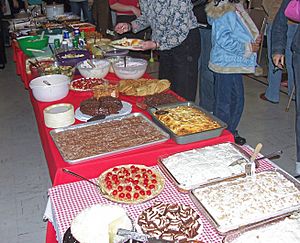
Letters from Minnesota residents in the mid-1800s describe frontier food. A farmer's wife wrote about waking up before four to skim milk, churn butter, and bake "6 loaves of bread & seven pumpkin pies."
In northern Minnesota, along the North Shore of Lake Superior, people have fished for generations. Ciscoes (lake herring), lake trout, lake whitefish, and rainbow smelt are still fished today. Smoked or sugar-cured trout is made from local fish. Walleye is Minnesota's state fish and is common on menus. It's often battered and deep-fried or grilled. Many restaurants feature walleye on their Friday night fish fry.
Walleye, trout, herring, crappie, lutefisk, wild rice, raspberry, blueberry, and strawberry are favorite ingredients in Minnesota. Typical sides include mashed potatoes, pickles, jello salad, boiled new potatoes, baked beans, and vegetables like sweet corn on the cob. Potatoes are often served with buttered rolls and homemade strawberry jam.
Scandinavian cuisine has greatly influenced Minnesota's food. Lefse and lutefisk are iconic dishes brought by Scandinavian immigrants. Lefse is a Norwegian flatbread made from flour, potatoes, cream, and butter. It's often made for Christmas dinner. Lutefisk is a traditional Nordic dish made from dried whitefish. Scandinavian rice pudding is also served during holidays. The cafe at the American Swedish Institute serves Swedish dishes like gravlax and Swedish meatballs with lingonberry jam.
Immigrants from Eastern Europe opened delicatessens, bakeries, and restaurants. They introduced dishes like varenyky, poppy seed roll, kluski, kolaches, and stuffed cabbage rolls. German immigrants brought kohlrabi.
Minnesota is known for its church potlucks, where hotdish is often served. Hotdish is a type of casserole dish. It's popular throughout the U.S., but the term "hotdish" is mainly used in Minnesota, Wisconsin, and the Dakotas. Hotdishes are filling comfort foods that are easy to make. "Tater Tot Hotdish" is popular. Since Minnesota is a top producer of wild rice, wild rice hotdishes are also common. Minnesota goulash, a mix of tomatoes, macaroni, ground beef, and creamed corn, is also popular. Dessert bars are the second essential for potlucks.
The Iron Range region in Upper Minnesota is known for Cornish pasties. These are meat and vegetable filled pastries brought by mine workers. Slovenian and Croatian immigrants brought the honey-nut bread called potica. Potica is very popular in northern Minnesota during Easter and Christmas. Porketta, a pork roast seasoned with fennel and garlic, was brought by Italian immigrants.
Minnesota is good for chicken, dairy, and turkey farms. Crops like corn, soybeans, and sugar beets are also grown. So, eggs and meat, along with potatoes and vegetables, are main foods. Recipes using local wild game like bison, deer, and moose are also common.
Several apple varieties were developed in Minnesota. These include the Honeycrisp apple and SweeTango. The Mesabi cherry is a Minnesota-bred cherry.
Food at the annual Minnesota State Fair can include watermelon pickles, baked beans, hot dogs, buffalo burgers, deep-fried cheese curds, and homemade apple pie.
Missouri
In Missouri, much of the food is influenced by different parts of the state. In the Ozarks, you'll find country ham, fried chicken, catfish, and frog legs. These are served with fried potatoes, baked beans, and biscuits.
People in Mid-Missouri and Northern Missouri eat a lot of beef (steaks, hamburgers, meatloaf) and pork (steak, roasts, chops). Sides often include potatoes and green vegetables. Barbecue, mainly pork and beef, is popular in both St. Louis and Kansas City.
In Southern Missouri, sweet tea is common. In Northern Missouri, most people prefer unsweetened tea. Missourians also love beer and bacon.
St. Louis features toasted ravioli, St. Louis-style pizza, and gooey butter cake. Kansas City is known for its K.C.-style BBQ-sauced burnt ends.
The Missouri Rhineland along the Missouri River is known for its wineries. Missourians love their local wines. They often eat summer sausage, cheese, and crackers with their wine.
Fishing is popular throughout the state. Fish fries are regular social events. They often feature catfish, largemouth bass, and crappie. Fried potatoes, morel mushrooms, and onion rings are also fried at these gatherings.
For breakfast, Missourians enjoy bacon, country ham, and breakfast sausage with eggs, hash browns, and toast or biscuits. Biscuits and gravy, pancakes, and breakfast casseroles are also favorites.
Nebraska
Many Germans from Russia settled in Nebraska. This led to one of the state's most famous dishes, the Runza sandwich. Large numbers of Czech immigrants also influenced the food. Wilber, Nebraska is the "Czech Capital of the U.S.A." It celebrates an annual Czech Days festival. Here, Czech food like kolaches, roast duck, and pork and dumplings are served.
Nebraska is also called the Cornhusker State because of all the corn grown there. Corn is a common part of late-summer and fall meals. You'll find it in dishes like corn souffle, corn chowder, cornbread, and corn on the cob.
The cheese frenchee, a deep-fried cheese sandwich, was invented in Lincoln, Nebraska. It became a regional favorite.
North Dakota
Food in North Dakota has been greatly influenced by Norwegians and Germans from Russia. Norwegian foods include lefse, lutefisk, krumkake, and rosettes. These are also common in Minnesota and other states with Norwegian descendants.
German-Russian food is mainly from the Schwarzmeerdeutsche (Black Sea Germans). They heavily settled in south-central and southwestern North Dakota. Popular German-Russian foods include kuchen, a thin, cheesecake-like pastry often filled with fruit. Fleischkuekle (or fleischkuechle) is a popular meat-filled flatbread that is deep-fried. Another specialty is knoephla, a dumpling soup that almost always includes potatoes.
Ohio
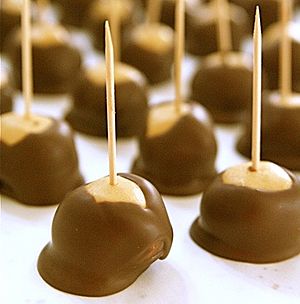
Buckeye candy is a sweet treat popular in Ohio. It's like a peanut butter cup. It's covered in chocolate, but with a peanut-butter fudge center showing. It looks like the nut from the state tree, the Buckeye.
Cincinnati-style chili is a Greek-inspired meat sauce. It's used as a topping for spaghetti or hot dogs. You can add red beans, chopped onions, and shredded cheese. These are called "ways."
A snack food in Ohio is sauerkraut balls. These are meatball-sized fritters with sauerkraut and some mix of ham, bacon, and pork. They were invented in the 1950s by two brothers in Shaker Heights, Ohio. An annual Sauerkraut Festival is held in Waynesville, Ohio.
Clam bakes are very popular in Northeast Ohio. This region was settled by people from Connecticut and New England. A typical Northeast Ohio clam bake includes clams, chicken, sweet potatoes, and corn. Unlike in New England, seaweed is not used. The clams, chicken, and sweet potatoes are all steamed together.
Barberton, Ohio is home to Barberton chicken. This is chicken deep-fried in lard. It was created by Serbian immigrants. It's usually served with a hot rice dish, vinegar coleslaw, and french fries.
South Dakota
South Dakota has been influenced by German and Russian immigrants. But the most notable group is the Sioux Native Americans.
One notable dish is Rocky Mountain oysters. Another dish is bierock, similar to meat-pie dishes from Central and Eastern Europe. Many South Dakotan desserts show European influences. Kuchen, from Germany, is popular. Another dish, more tied to Native Americans, is wojapi. This is a berry sauce from the Lakota tribes. Wojapi sometimes comes with frybread. Frybread is also used for Navajo tacos, where meat is served on top.
Wisconsin
Wisconsin is "America's Dairyland." It has many frozen custard stands, especially around Milwaukee. The state also has a special connection with Blue Moon ice cream. It's one of the few places where you can find this flavor. Wisconsin is also known for its many cheesemakers.
The most common Wisconsin dessert is the cream puff. This is a famous treat at the Wisconsin State Fair. The city of Racine is known for its Danish kringle. This is a sweet, flaky pastry often served as a dessert.
The Friday night fish fry, often battered and fried perch or walleye, is traditional throughout Wisconsin. In northeast Wisconsin, along Lake Michigan, the Door County fish boil is popular.
"Booyah" is another common and hearty Wisconsin meal, especially in the Northeast. The word might come from a French word meaning "broth."
Wisconsin food also features a lot of sausage, or wurst. The state is a major producer and consumer of summer sausage and brats.
Restaurants and Eateries
Dark ales have been popular in America since colonial times. Light-colored German lager arrived in the mid-1800s. Beer halls became popular in the U.S. with German immigrants. Beer halls were seen as places where working-class families could eat and drink together. They served traditional food like sausages, sauerbraten, and sauerkraut. Beer halls continued in the Midwest after Prohibition.
The popularity of Midwestern fast food like pizza and burgers grew as people moved away from drive-in restaurants. "Car hops" who served customers in their cars were replaced by the franchise model. Cities like New York didn't want fast food to compete with local places. But as suburbs grew in the 1950s, fast-food chains expanded into these areas that didn't have many restaurants.
Major Midwestern fast-food chains include McDonald's, Wendy's, Domino's, and Pizza Hut. The growth of these chains was helped by the development of interstate roads through the Midwest.
The origin of "fast food" is not certain. But one possibility is a hamburger stand founded by Walter Anderson in Wichita, Kansas. This chain is known today as White Castle. It offered a simple menu with hamburgers, Coca-Cola, and coffee. By the 1920s, White Castle was a nationally recognized chain.
McDonald's was first founded in California in 1940. But it was bought by Ray Kroc and moved to Des Plaines, Illinois in 1955. Other burger chains include Winstead's and Schoop's Hamburgers.
Several restaurant chains have roots in the Minneapolis-St. Paul area. These include Famous Dave's and Buca di Beppo.
Portillo's Restaurants is another Midwestern fast-food chain known for its hot dogs. Lion's Choice is best known for its roast beef sandwiches. This chain is mostly in Missouri, Kansas, and Illinois.
Wisconsin chain Culver's is known for its frozen custard and root beer. Culver's uses local dairy products like cheese and butter. Happy Joe's is known for its taco pizza.
Other notable chains include Harold's Chicken Shack, Skyline Chili, Spangles, Big John Steak & Onion, Graeter's, Maid-Rite, and Cousins Subs.
Pizzerias serving deep-dish pizza include Gino's East and Giordano's Pizzeria. Papa John's started by selling pizzas out of a pub in Jeffersonville, Indiana.
Typical Midwestern Dishes
These dishes are common in the Midwest. While not all are found *only* in the Midwest, they often have special Midwestern ways of being made.
- 7-layer dip
- Barbecue
- Beans
- Beef, especially steak, pot roast, and prime rib
- Bread-and-butter pickles
- Beer
- Beer cheese soup
- Brain sandwiches
- Brandy
- Bratwurst
- Buckeyes
- Cabbage
- Cabbage roll, also known as stuffed cabbage
- Cheese, including cheese curds
- Chicken Vesuvio
- Chicken paprikash
- Chislic
- Cole slaw
- Coney Island hot dog
- Deep-fried bacon
- Diner fare
- Door County fish boil
- Doughnuts
- Duck
- Freshwater fish, including catfish, perch, trout, walleye, and whitefish, often breaded and fried
- Fried chicken
- Frog legs
- Frozen custard
- Fruit, especially apples, blueberries, cherries, cranberries, peaches, and strawberries
- Fruit wines
- Fruit pies
- German potato salad
- Goulash
- Hamburgers
- Head cheese
- Horseshoe sandwich
- Hotdish or casseroles
- Ice cream cone
- Italian beef
- Gyro (loaf-style)
- Jello salads
- Johnny Marzetti
- Lefse
- Lutefisk
- Maple syrup
- Meatloaf
- Morels
- Pancakes
- Pasties
- Pea salad
- Persimmon pudding
- Pierogi
- Pizza, with several regional styles
- Pork
- Potatoes, including mashed potatoes, potato pancakes, and potato salads
- Ranch dressing
- Ramps
- Roast beef
- Sauerbraten
- Sauerkraut
- Sausage, including bratwurst, kielbasa, summer sausage, ring bologna, and other ethnic types, as well as hot dogs, with several regional styles
- Shrimp DeJonghe
- Steak
- Stollen
- Sugar cream pie
- Sweet corn, on-the-cob, in creamed corn, and in corn relish
- Turkey
- Wild rice


